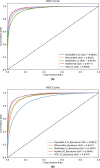DiaNet v2 deep learning based method for diabetes diagnosis using retinal images
- PMID: 38238377
- PMCID: PMC10796402
- DOI: 10.1038/s41598-023-49677-y
DiaNet v2 deep learning based method for diabetes diagnosis using retinal images
Abstract
Diabetes mellitus (DM) is a prevalent chronic metabolic disorder linked to increased morbidity and mortality. With a significant portion of cases remaining undiagnosed, particularly in the Middle East North Africa (MENA) region, more accurate and accessible diagnostic methods are essential. Current diagnostic tests like fasting plasma glucose (FPG), oral glucose tolerance tests (OGTT), random plasma glucose (RPG), and hemoglobin A1c (HbA1c) have limitations, leading to misclassifications and discomfort for patients. The aim of this study is to enhance diabetes diagnosis accuracy by developing an improved predictive model using retinal images from the Qatari population, addressing the limitations of current diagnostic methods. This study explores an alternative approach involving retinal images, building upon the DiaNet model, the first deep learning model for diabetes detection based solely on retinal images. The newly proposed DiaNet v2 model is developed using a large dataset from Qatar Biobank (QBB) and Hamad Medical Corporation (HMC) covering wide range of pathologies in the the retinal images. Utilizing the most extensive collection of retinal images from the 5545 participants (2540 diabetic patients and 3005 control), DiaNet v2 is developed for diabetes diagnosis. DiaNet v2 achieves an impressive accuracy of over 92%, 93% sensitivity, and 91% specificity in distinguishing diabetic patients from the control group. Given the high prevalence of diabetes and the limitations of existing diagnostic methods in clinical setup, this study proposes an innovative solution. By leveraging a comprehensive retinal image dataset and applying advanced deep learning techniques, DiaNet v2 demonstrates a remarkable accuracy in diabetes diagnosis. This approach has the potential to revolutionize diabetes detection, providing a more accessible, non-invasive and accurate method for early intervention and treatment planning, particularly in regions with high diabetes rates like MENA.
© 2024. The Author(s).
Conflict of interest statement
The authors declare no competing interests.
Figures







References
-
- World Health Organization. Diabetes. https://www.who.int/news-room/fact-sheets/detail/diabetes.
-
- Musleh S, Nazeemudeen A, Islam MT, El Hajj N, Alam T. A machine learning based study to assess bone health in a diabetic cohort. Inform. Med. Unlocked. 2022;33:101079.
-
- International Diabetes Federation . IDF Diabetes Atlas. 10. International Diabetes Federation; 2021. - PubMed
-
- Ogurtsova K, et al. Idf diabetes atlas: Global estimates of undiagnosed diabetes in adults for 2021. Diabetes Res. Clin. Pract. 2022;183:109118. - PubMed
MeSH terms
Substances
LinkOut - more resources
Full Text Sources
Medical
Research Materials

